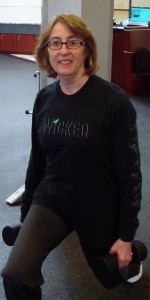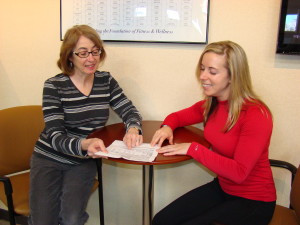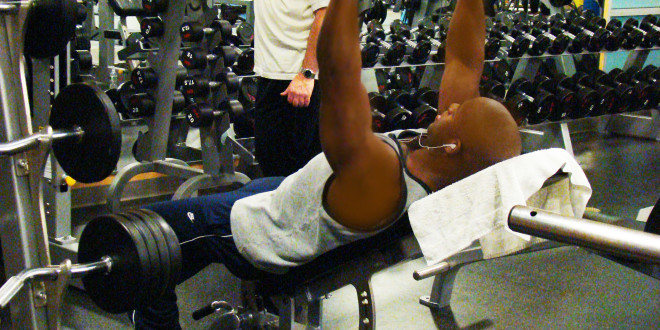by Michelle Sutton-Kerchner
We often work to build muscle. It’s time to focus on those bones! Without them, where would the muscle be …
Bone health is assumed. Our bones are there, doing their job for us and only getting recognized when bumped or broken. When bone deterioration begins to occur, it usually comes as a shock. It shouldn’t. At around 20 years old, the body’s bone mass peaks. Then, as we age, we lose bone mass. Unfortunately, when bone health becomes questionable, factors like age make rebuilding bones a controversial possibility.
Osteoporosis is a condition where bones become weak, brittle, and easily broken. Like other tissue, bone tissue is continuously absorbed and replaced. When tissue is removed more quickly than it is replenished, osteoporosis occurs.
Lack of calcium, with its vitamin D counterpart to help absorb it, is one contributor to osteoporosis. Other contributing factors include:
Gender: females, especially Caucasian or Asian decent;
Genetics: parent or sibling with osteoporosis;
Small body structure;
Sedentary lifestyle;
Long-term deficiency in calcium and vitamin D;
Hormone shifts in later years.
Half of all women develop osteoporosis by age 60. Although predominately considered a women’s health issue, 30 percent of reported osteoporosis cases are by men. Reduced sex hormones common with aging, similar to those experienced by women in menopause, is cited as a frequent cause. Fifty percent of men who suffer hip fractures die within one year.
Whether already diagnosed with osteoporosis or trying to prevent its onset, it is never too late to take action (in the most literal sense). Member Christine DeFrehn exemplifies the positive effects lifestyle improvements can have on osteoporosis. Unwilling to take the pharmaceutical approach to managing her condition, she chose a more holistic journey. It may not have been the easier choice, but she was determined to avoid a lifetime of medication and potentially dangerous side-effects.
Blind Faith

At 59 years old, Christine decided to defy bone loss without medication. “I didn’t like what I read about the recommended osteoporosis drugs, but I wanted to arrest the progress of bone loss,” she shares. Faithfully, she committed to the exercise program Personal Trainer Morgan Ohr created for her. Simultaneously, she adopted healthy eating tips for consuming more calcium from Registered Dietician Helene Dubin.
Unlike weight loss programs, the success of which can be measured using a body mass index calculator or scale, Christine’s steadfast commitment was based on trust– in her plan and the professionals who helped create it. “I could not measure the effect of what I was doing. I could only hope bone loss was being reversed,” she admitted.
A follow-up bone density scan showed the reward. Christine’s bone loss was arrested. Even better– she gained a statistically significant increase in bone density in her spine and hip. “The osteoporosis previously found is gone! In10 months, I reversed deterioration that occurred over three years.”
Christine’s How-To
Christine credits much of her success to her personal trainer, from whom she learned the correct exercises and how to safely perform them. They targeted areas weakened by her condition and built them back to strength. Trainer Morgan also became a support buddy for Christine in her determination to overcome osteoporosis, a condition many rightfully fear. Without bone strength, life can be crippling.

Regardless of outside interventions, Christine deserves praise of her own. In a society where many take the quick and easy means to an end, she decided her body’s best option and made it work. With motivating scan results, Christine can confidently proceed with her new lifestyle. “I know my new exercises and way of eating are right for me. I am on track for a healthy future, fortunate to be in the care of the Center’s professionals.”
With Christine’s success to inspire, let’s build some bone! Combine strength training, weight-bearing exercises, and stretches for the most effective workout. Here are recommendations to combat osteoporosis from our personal training team.
Strengthening & Weight-Bearing
Strength training helps muscles and bones in your arms and upper spine. Weight-bearing workouts mainly affect bones in your legs, hips, and lower spine. Some weight-bearing activities include walking, stair climbing, and impact-producing sports. The latter is probably best avoided if already diagnosed with osteoporosis.
Slowly introduce free weights and weight machines to your regimen. These methods focus directly on bones to help decrease mineral loss.
Remind Bones They Are Needed
During exercise, muscles pull against bones to bring them “to life.” This movement stimulates bone density production. For maximum impact, bones and joints should bear more weight than provided by normal bodyweight. This requires an external resistance, such as that gained through the use of dumbbells, barbells, or exercise equipment, to provide the stimulation necessary to promote an increase in bone density.
Don’t be intimidated by traditional thoughts of athletes pumping iron. A personal trainer can show you the everyday-person’s method to weight training. The kind to help increase bone density, not necessarily your odds at winning a weightlifting championship.
Check the Group Fitness schedule for classes that use resistance equipment to power up a workout. Talk with instructors and trainers to adapt a particular exercise that might be too challenging or risky for your current bone structure. Be sure your fitness routine does not include movement that puts you at risk for falling.
Aquatic workouts provide gentle resistance without jarring or joint strain. Bones can strengthen without the impact noticed on land. Movement done in water makes muscles work harder while simultaneously building bone. If recovering from a fracture, water fitness is the ideal method for gaining strength and keeping momentum while minimizing further injury.
Stretching
Stretching increases flexibility. Moving joints through their full range-of-motion helps maintain good balance, avoid injury, and improve posture. Underwater stretches done in the pool can be soothing and effective. Consider Gentle or Chair Yoga class, Pilates Mat class, or Pilates Reformer sessions. If you have osteoporosis, avoid stretches that flex the spine or require you to bend at the waist.
Start Young
 Take advantage of life’s early decades for bone building. Create an active lifestyle and consume enough calcium. Calcium is one of the most important minerals for bone health. Aside from low-fat milk and dairy, calcium is plentiful in green leafy vegetables, salmon, fortified cereals, and sardines. Lactose-free products still contain the same calcium content.
Take advantage of life’s early decades for bone building. Create an active lifestyle and consume enough calcium. Calcium is one of the most important minerals for bone health. Aside from low-fat milk and dairy, calcium is plentiful in green leafy vegetables, salmon, fortified cereals, and sardines. Lactose-free products still contain the same calcium content.
A lifelong commitment to exercise at an early age delivers the most benefits. However, exercise can help your bones no matter when you begin. (Just ask Christine!) Use risk factors or a borderline diagnosis as motivation for prevention, not instigation to quit the fight before any battle may begin. And, should the battle begin, be ready. Throw your weight around.
Sources
“10 Ways to Prevent or Reverse Osteoporosis,” by Catherine Waller M.D. at www.ezinearticles.com.
Osteoporosis– Overview, PubMed Health at http://www.ncbi.nlm.nih.gov/pubmedhealth.
Image Credits
Calcium chef: http://www.flickr.com/photos/nutritioneducation/3834583329/
 Fitness & Wellness News Your Source for Fitness News, Wellness News, Health News, and Nutrition News!
Fitness & Wellness News Your Source for Fitness News, Wellness News, Health News, and Nutrition News!





Fitness is always good for health.Thanks for posting this article.